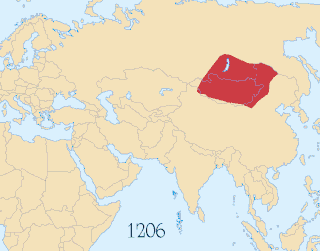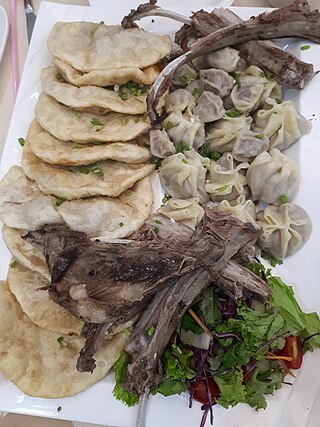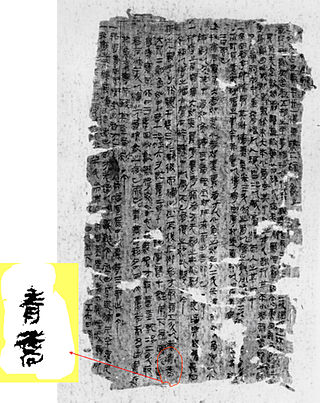Chinese food therapy is a mode of dieting rooted in Chinese beliefs concerning the effects of food on the human organism, and centered on concepts such as seasonal eating and in moderation. Its basic precepts are a mix of Taoist Wuxing and eight principle theory that are concepts drawn from the modern representation of traditional Chinese medicine.

Noodles are a type of food made from unleavened dough which is either rolled flat and cut, stretched, or extruded, into long strips or strings. Noodles are a staple food in many cultures and made into a variety of shapes. The most common noodles are those derived from either Chinese cuisine or Italian cuisine. Chinese noodles are known by a variety of different names, while Italian "noodles" are known as pasta.

The Mongol Empire of the 13th and 14th centuries was the largest contiguous empire in history. Originating in present-day Mongolia in East Asia, the Mongol Empire at its height stretched from the Sea of Japan to parts of Eastern Europe, extending northward into parts of the Arctic; eastward and southward into parts of the Indian subcontinent, mounted invasions of Southeast Asia, and conquered the Iranian Plateau; and reached westward as far as the Levant and the Carpathian Mountains.

A cookbook or cookery book is a kitchen reference containing recipes.

Manti is a type of dumpling mainly found in Turkish cuisine, Armenian cuisine and Central Asian cuisine but also in West Asia, South Caucasus, and the Balkans. Manti is also popular among Chinese Muslims, and it is consumed throughout post-Soviet countries, where the dish spread from the Central Asian republics. The dumplings typically consist of a spiced meat mixture, usually lamb or ground beef, wrapped in a thin dough sheet which is then boiled or steamed. The size and shape of manti vary significantly depending on geographic location.
Traditional Mongolian medicine developed over many years among the Mongolian people. Mongolian medical practice spread across their empire and became an ingrained part of many other people's medical systems.
The history of Chinese cuisine is marked by both variety and change. The archaeologist and scholar Kwang-chih Chang says "Chinese people are especially preoccupied with food" and "food is at the center of, or at least it accompanies or symbolizes, many social interactions". Over the course of history, he says, "continuity vastly outweighs change." He explains basic organizing principles which go back to earliest times and give a continuity to the food tradition, principally that a normal meal is made up of a plant based products consisting of grains, starch vegetables and/or fish based dishes with very little red meat consumption.

Mongolian cuisine predominantly consists of dairy products, meat, and animal fats. The most common rural dish is cooked mutton. In the city, steamed dumplings filled with meat—"buuz"— are popular.

Güllaç is a Turkish dessert made with milk, rose water, pomegranate and a special kind of pastry. It is consumed especially during Ramadan.

Baklava is a layered pastry dessert made of filo pastry, filled with chopped nuts, and sweetened with syrup or honey. It was one of the most popular sweet pastries of Ottoman cuisine.

Hu Sihui was a Chinese court therapist and dietitian during Yuan dynasty. He is known for his book Yinshan zhengyao, that became a classic in Chinese medicine and Chinese cuisine. He was the first to empirically discover and clearly describe deficiency diseases.

The Wushi'er Bingfang, or Recipes for Fifty-Two Ailments, is an ancient Chinese medical text that was discovered in 1973 in Mawangdui in a tomb that was sealed in 168 BCE under the Han dynasty. The text was copied in seal script on sheets of silk around 215 BCE, under the Qin dynasty, but might have dated from even earlier. Modern editors chose its title because the text starts with a list of fifty-two ailments for which recipes are given. The formulary presents more than 250 exorcistic and drug-based cures for ailments such as warts, hemorrhoids, inguinal swellings, and snake bites. Among other medical treatments, the text also recommends lancing and cauterization, but mention neither acupuncture nor moxibustion.
Shuanggudui is an archeological site located near Fuyang in China's Anhui province. Shuanggudui grave no. 1, which belongs to Xiahou Zao (夏侯灶), the second marquis of Ruyin (汝陰侯), was sealed in 165 BCE in the early Han dynasty. Excavated in 1977, it was found to contain a large number of texts written on bamboo strips, including fragments of the Classic of Poetry and the Songs of the South, a text on breathing exercises, a "year table" (年表) recounting historical events, a manual on dogs, a version of the I Ching (Yijing) that differs from the received one, and artifacts including the oldest known cosmic board, a divinatory instrument. Like Mawangdui and Guodian, two other tombs from the area of the old state of Chu, the Shuanggudui find has shed great light on the culture and practices of the early Han dynasty.

The (1406) Jiuhuang bencao, written by the Ming dynasty prince Zhu Su (朱橚), was the first illustrated botanical manual for famine foods—wild food plants suitable for survival during times of famine.

During the Yuan dynasty (1271–1368) of China, many scientific and technological advancements were made in areas such as mathematics, medicine, printing technology, and gunpowder warfare.

Sülen are the so-called "boiled pot" dishes of ancient Mongolian cuisine. They are the most significant category of dishes attested to in the Yinshan Zhengyao (YSZY), making up 12.3% off the 219 recorded recipes of the Khan's court. The texture of dishes cooked by the boiling pot method varies from pilafs and very thick stews to soups, all the recipes in Juan 1 of the YSZY were made using the same base mutton and cardamom broth as a cooking liquid.

Shilin Guangji is an encyclopedia written by Chen Yuanjing during the Yuan dynasty. The book contains text written in Chinese characters, Mongolian script, and the ʼPhags-pa script. Chen Yuanjing was a native of Chong'an (崇安) in Fujian and was born during the later years of the Southern Song dynasty. The encyclopedia contains a wealth of info on the daily life during the Mongol Empire and Yuan dynasty, including illustrations, maps and cartography. Among historical texts, it was easy to understand and popular even after the Yuan dynasty. Chen's book was used by scholars during the Ming and Qing dynasties to compile their own encyclopedias.
Li Yong, courtesy name Taihe, also known as Li Beihai, was a Chinese politician, writer, and calligrapher active during the Tang dynasty.
Beiji qianjin yaofang, literally Essential Formulas Worth a Thousand in Gold for Emergencies, is a Chinese medical text by Tang-dynasty physician Sun Simiao, first published in 652. A sequel was published in 682.
The Xinxiu bencao, also known as the Tang bencao, is a Chinese pharmacopoeia written in the Tang dynasty by a team of officials and physicians headed by editor-in-chief Su Jing. It borrowed heavily from—and expanded upon—the earlier Bencao jing jizhu by Tao Hongjing. The text was first published in 659; although it is now considered lost in China, at least one copy exists in Japan, where the text had been transmitted to in 721.














